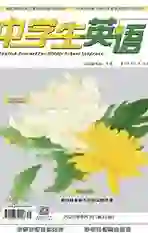科学家们说: 嗨,徒步旅行者,别堆石头了! Scientists Say: Hey, Hikers, Stop Stacking1 Rocks!
2020-12-21景一
景一
If youve been out on a hiking trail2 lately, youve probably noticed them suddenly popping3 up everywhere—small, intentionally4 stacked piles of rocks, called cairns5. And environmentalists6 worldwide are increasingly alarmed, because moving rocks have great influence on insects, animals and even the land.
如果你最近出去徒步旅行,可能会注意到突然出现在各个地方的、小小的、故意堆起的岩石堆,它们被称为石堆纪念碑。全世界的环保人士也感到越来越震惊,因为移动岩石会给昆虫、动物甚至土地带来巨大的影响。
People have been stacking rocks since the dawn of time, for directional or burial7 purposes. More recently, park officials began creating them on hiking trails—especially where people easily get lost——to make sure people dont get lost.
人们从远古时起就开始堆石头,为了定位方向或作为墓葬。最近,公园管理人员开始在徒步旅行的小径上堆石头块——特别是在容易让人迷路的小径上——以确保人们不会迷路。
In 1896, a man named Waldron Bates created a special style of hiking cairn in Acadia National Park. The Bates cairns, as they became known, consisted8 of a rectangular stone balanced on two legs, then topped with one stone pointing to the trail. The places of these cairns were taken by standard ones in the 1950s and 1960s. But the park began rebuilding the historic Bates cairns in the 1990s. Acadia now contains a mixture of both.
1896年,一个名叫沃尔德伦·贝茨的人在阿卡迪亚国家公园创造了一种特别的徒步石堆风格。贝茨石堆,正如人们所知的,是把一块长方形的石头平衡地放在两块石头上,然后顶部放一块指向小径的石头。这些石堆在20世纪50年代和60年代被标准的石堆所取代。但是公园在90年代开始重建有历史意义的贝茨石堆。阿卡迪亚国家公园中现在有这两种石堆。
What scientists today pay most attention to is the new practice of creating rock piles as an art form, or for more popular social media posts, for stacking rocks is not a good practice. Many insects and animals head under rocks to live or hide. So move a rock, and you might destroy a home. Stack a few, and you may have just exposed9 the insects and animals to their hunters.
今天科学家们关注的是创造岩堆成了一种艺术形式,或是为了使社交媒体的帖子更受欢迎,因为堆砌岩石不是一种好的做法。许多昆虫和动物在岩石下生存或躲藏。所以搬走一块石头,你可能会毁了一个窝。堆几块石头,你可能就将昆虫和动物暴露给了它们的捕猎者。
Whether youre stacking rocks in the woods, on the beach or in the desert, your actions could knock out an area. Or, in the worst case, threaten10 a species11 in danger.
不管你是在樹林里、海滩上还是在沙漠里堆石头,你的行为都可能会破坏一个区域。或者,最坏的情况是会威胁到濒危物种。
Some rock-stacking fans note theyre being responsible by returning rocks to the spots where they found them after creating their artwork. However, the minute you move rocks, you may destroy a species place in an unrecoverable manner. Whats more, moving rocks in any way may break up the soil, as the dirt once hid under them is now more easily to be washed away.
一些岩石堆的爱好者注意到,他们有责任在完成创作后把石头放回发现它们的地方。然而,当你移动岩石时,你可能会以一种无法恢复的方式破坏了一个物种的栖息地。此外,以任何方式移动岩石都可能导致土壤分解,因为藏在岩石下面的泥土现在更容易被冲走。
Should you come upon stacked rocks, especially in national parks, leave them alone. And if youre hiking, dont follow them. Check with park officials before setting out on a hike, as every park has different rules about cairns. You dont want to follow those that may have been randomly12 stacked by visitors.
如果你碰到堆積的岩石,尤其是在国家公园中时,不要碰它们。如果你在徒步旅行,不要跟着它们走。在开始徒步旅行之前,同公园管理人员核实一下,因为每个公园对石堆都有不同的规定。你肯定不想跟着那些可能是由游客随机堆的石堆走。
In the end, let your actions be guided by this important rule: Leave no trace13.
最后,让你的行动遵循这一重要原则:不留痕迹。
(英语原文选自:science.howstuffworks.com)
【Notes】
1. stack [■] v. 堆起;摞起 2. trail [■] n. (荒野)小路
3. pop [■] v. 突然出现
4. intentionally [■] adv. 故意地,有意地 5. cairn [■] n. 石冢;石堆纪念碑
6. environmentalist [■] n. 环保人士;环境问题专家
7. burial [■] adj. 埋葬的 8. consist [■] v. 由……组成
9. expose [■] v. 使曝光 10. threaten [■] v. 威胁
11. species [■] n. 物种;种类 12. randomly [■] adv. 随便地,任意地 13. trace [■] n. 痕迹
▲Discussion议一议:
Whats the writers opinion? Do you agree? Why? 作者的观点是什么?你支持这个观点吗?为什么?
▼欢迎投稿!
你对上面的几个问题有什么样的想法呢?快快来稿同我们分享你的感想和你的故事吧!你的稿件将有机会在我们的“寒窗心语”栏目中刊登并向大家展示!
[投稿须知]
1. 英文60~150词左右;
2. 电子稿件内请附上你的中文简介,包括就读学校、年级、班级、姓名、兴趣等,以及电子版生活照一张;
3. 电子稿件内请留下你的联系方式,以便我们在采用稿件后和你及时联系并寄送样刊;
4. 电子稿件请发至邮箱:785704986@qq.com,邮件名请注明“九年级寒窗心语”。
